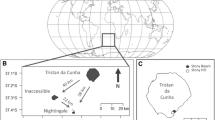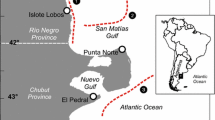Abstract
Foraging sites, diet, and diving behavior of chick-rearing Adélie penguins, Pygoscelis adeliae, in fast sea-ice areas were investigated during two consecutive seasons with contrasting sea-ice conditions. During 1995/1996, fast sea ice covered the foraging range of penguins during the whole breeding season. In contrast, during 1996/1997, sea ice covered the area in December 1996, but gradually thinned and finally broke up, so that open sea appeared along the coast during February 1997. Foraging sites were concentrated in a small area in 1995/1996 and spread over a wider area in 1996/1997 as more small open-water areas were available. In both seasons, parents traveled to more distant foraging sites as the season progressed and, consequently, the foraging-trip duration increased. In both years, Euphausia superba and Pagothenia borchgrevinki dominated the diet in the early part of the season, while later in the season penguins fed mainly on E. superba in 1995/1996 and Pagothenia borchgrevinki and E. crystallorophias in 1996/1997. In 1995/1996, penguins tended to dive deeper—albeit for a relatively shorter duration—when feeding mainly on krill compared to when feeding on fish. In 1996/1997, there was no difference in the dive depth and duration between krill- and fish-eating trips. Our results suggest that prey distribution changes annually and seasonally, probably according to sea-ice conditions, and that consequently penguins modify their foraging sites, diving patterns, and diet according to these changes.






Similar content being viewed by others
References
Ainley DG, Wilson PR, Barton KJ, Ballard G, Nur N, Karl B (1998) Diet and foraging effort of Adélie penguins in relation to pack-ice conditions in the southern Ross Sea. Polar Biol 20:311–319
Ancel A, Kooyman GL, Ponganis PJ, Gendner J-P, Lignon J, Mestre X, Hiun N, Thorson PH, Robinsson P, Le Maho Y (1992) Foraging behaviour of emperor penguins as a resource detector in winter and summer. Nature 360:336–339
Andriashev AP (1970) Cryopelagic fishes of the Arctic and Antarctic and their significance in polar ecosystems. In: Holdgate MW (ed) Antarctic ecology, vol 1. Academic, London, pp 297–304
Ballard G, Ainley DG, Ribic CA, Barton KR (2001) Effect of instrument attachment and other factors on foraging trip duration and nesting success of Adélie penguins. Condor 103:481–490
Bannasch R, Wilson RP, Culik B (1994) Hydrodynamic aspects of design and attachment of a back-mounted device in penguins. J Exp Biol 194:83–97
Barrett RT, Furness RW (1990) The prey and diving depths of seabirds on Hornoy, North Norway after a decrease in the Barents Sea capelin stocks. Ornis Scand 21:179–186
Bost C-A, Zorn T, Le Maho Y, Duhamel G (2002) Feeding of diving predators and diel vertical migration of prey: king penguins' diet versus trawl sampling at Kerguelen Islands. Mar Ecol Prog Ser 227:51–61
Cairns DK (1987) Seabirds as indicators of marine food supplies. Biol Oceanogr 5:261–271
Charrassin J-B, Bost C-A (2001) Utilisation of the oceanic habitat by king penguins over the annual cycle. Mar Ecol Prog Ser 221:285–297
Charrassin J-B, Bost C-A, Putz K, Lage J, Dahier T, Zorn T, Le Maho Y (1998) Foraging strategies of incubating and brooding king penguins Aptenodytes patagonicus. Oecologia 114:194–201
Clarke JR, Manly B, Kerry K, Gardner H, Franchi E, Corsolini S, Focardi S (1998) Sex differences in Adélie penguin foraging strategies. Polar Biol 20:248–258
Croll DS, Gaston AJ, Burger AE, Konnoff D (1992) Foraging behavior and physiological adaptation for diving in thick-billed murres. Ecology 73:344–356
Endo Y, Asari H, Watanuki Y (2000) Biological characteristics of euphausiids preyed upon by Adélie penguins in relation to sea-ice conditions in Lützow-Holm Bay in 1995/96. Polar Biosci 13:66–73
Endo Y, Asari H, Watanuki Y, Kato A, Kuroki M, Nishikawa J (2002) Biological characteristics of euphausiids preyed upon by Adélie penguin, Pygoscelis adeliae, breeding at Hukuro Cove, Lützow-Holm Bay, Antarctica. Polar Biol 25:730–738
Grémillet D, Wilson RP, Storch S, Gary Y (1999) Three-dimensional space utilization by a marine predator. Mar Ecol Prog Ser 183:263–273
Irons DB (1998) Foraging area fidelity of individual seabirds in relation to tidal cycles and flock feeding. Ecology 79:647–655
Kato A, Watanuki Y, Naito Y (1998) Benthic and pelagic foraging of two Japanese cormorants, determined by simultaneous recording of location and diving activity. J Yamashina Inst Ornithol 30:101–108
Mehlum F, Watanuki Y, Takahashi A (2001) Diving behavior and foraging habitats of Brünnich's guillemots Uria lomvia breeding in the High-Arctic. J Zool Lond 255:413–423
Montevecchi WA (1993) Birds as indicators of change in marine prey stocks. In: Furness RW, Greenwood JJD (eds) Birds as monitors of environmental change. Chapman & Hall, London, pp 217–266
Moriwaki K, Yoshida Y (2002) Bathymetric chart of Lützow-Holmbukta. Special Map Series of National Institute of Polar Research, no. 4b
Rodary D, Bonneau W, Le Maho Y, Bost CA (2000a) Benthic diving in male emperor penguins Aptenodytes forsteri foraging in winter. Mar Ecol Prog Ser 207:171–181
Rodary D, Wienecke BC, Bost CA (2000b) Diving behavior of Adélie penguins (Pygoscelis adeliae) at Dumont D'Urville, Antarctica: nocturnal patterns of diving and rapid adaptations to changes in sea-ice condition. Polar Biol 23:113–120
Ropert-Coudert Y, Kato A, Bost C-A, Rodary D, Sato K, Le Maho Y, Naito Y (2002) Do Adélie penguins modify their foraging behaviour in pursuit of different prey? Mar Biol 140:647–652
Takahashi A (2000) Foraging ecology and reproduction of Adélie penguins in fast sea ice areas (in Japanese). PhD Thesis, Graduate University for Advanced Studies, Hayama
Wanless S, Harris MP, Morris JA (1990) A comparison of feeding areas used by individual common murres (Uria aalge), razorbills (Alca torda) and an Atlantic puffin (Fratercula arctica) during the breeding season. Colon Waterbirds 13:16–24
Watanuki Y, Mori Y, Naito Y (1992) Adélie penguin parental activities and reproduction: effects of device size and timing of its attachment during chick rearing period. Polar Biol 12:539–544
Watanuki Y, Kato A, Mori Y, Naito Y (1993) Diving performance of Adélie penguins in relation to food availability in fast sea ice areas: comparison between years. J Anim Ecol 62:634–646
Watanuki Y, Mori Y, Naito Y (1994) Euphausia superba dominates in the diet of Adélie penguins feeding under sea-ice in the shelf areas of Enderby Land in summer. Polar Biol 14:429–432
Watanuki Y, Kato A, Naito Y, Robertson G, Robinson S (1997) Diving and foraging behaviour of Adélie penguins in areas with and without fast sea-ice. Polar Biol 17:296–304
Watanuki Y, Miyamoto Y, Kato A (1999) Dive bouts and feeding sites of Adélie penguins rearing chicks in area with fast sea-ice. Waterbirds 22:120–129
Watanuki Y, Kato A, Sato K, Niizuma Y, Bost C-A, Le Maho Y, Naito Y (2002) Parental mass change and food provisioning in Adélie penguins rearing chicks in colonies with contrasting sea-ice conditions. Polar Biol 25:672–681
Weimerskirch H, Salamolard M, Sarrazin F, Jouventin P (1993) Foraging strategy of wandering albatrosses through the breeding season: a study using satellite telemetry. Auk 110:325–342
Williams TD, Rothery P (1990) Factors affecting variation in foraging and activity patterns of gentoo penguins (Pygoscelis papua) during the breeding season at Bird Island, South Georgia. J Appl Ecol 27:1042–1054
Wilson RP (1984) An improved stomach pump for penguins and other seabirds. J Field Ornithol 55:110–112
Wilson RP, Grant WS, Duffy DC (1986) Recording devices on free-ranging marine animals: does measurement affect foraging performance? Ecology 67:1091–1093
Wilson RP, Coria NR, Spairani HJ, Adelung D, Culik B (1989) Human-induced behaviour in Adélie penguins Pygoscelis adeliae. Polar Biol 10:77–80
Acknowledgements
We greatly appreciated the logistic support from all the members of JARE 36, 37, and 38, especially Y. Miyamoto and H. Ichikawa, who gave us valuable help in the field. T. Iwami kindly identified fish species and provided unpublished data. We thank Y. Ropert-Coudert for his help in the preparation of figures and for his valuable comments on the manuscript. G. Hosie and three anonymous referees greatly helped us to improve the manuscript.
Author information
Authors and Affiliations
Corresponding author
Rights and permissions
About this article
Cite this article
Kato, A., Watanuki, Y. & Naito, Y. Annual and seasonal changes in foraging site and diving behavior in Adélie penguins. Polar Biol 26, 389–395 (2003). https://doi.org/10.1007/s00300-003-0493-0
Received:
Accepted:
Published:
Issue Date:
DOI: https://doi.org/10.1007/s00300-003-0493-0




